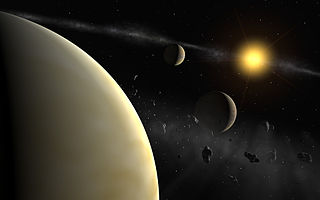Related Research Articles

HD 69830 d is an exoplanet likely orbiting within the habitable zone of the star HD 69830, the outermost of three such planets discovered in the system. It is located approximately 40.7 light-years (12.49 parsecs, or 3.8505×1014 km) from Earth in the constellation of Puppis. The exoplanet was found by using the radial velocity method, from radial-velocity measurements via observation of Doppler shifts in the spectrum of the planet's parent star.

HD 164922 is a seventh magnitude G-type main sequence star in the constellation of Hercules. To view it, binoculars or a telescope are necessary, as it is too faint to be visible to the naked eye. It is 71.7 light-years distant from the Earth. It will soon evolve away from the main-sequence and expand to become a red giant.
HD 164922 b is an exoplanet orbiting the star HD 164922 about 72 light-years from Earth in the constellation Hercules. Its inclination is not known, and its true mass may be significantly greater than the radial velocity lower limit of 0.36 Jupiter masses. The planet also has a low eccentricity, unlike most other long period extrasolar planets – 0.05 – about the same as Jupiter and Saturn in the Solar System. The exoplanet was found by using the radial velocity method, from radial-velocity measurements via observation of Doppler shifts in the spectrum of the planet's parent star.
TW Hydrae b is a likely extrasolar planet orbiting the young T Tauri star TW Hydrae approximately 176 light-years (54 parsecs, or nearly 1.665×1016 km) away in the constellation of Hydra. It is likely a Neptune-like planet orbiting at a distance of nearly 22 AU from its star.
BD+14 4559 b, named Pirx, is an exoplanet orbiting the K-type main sequence star BD+14 4559 about 161 light-years (49 parsecs, or nearly 1.5×1015 km) from Earth in the constellation Pegasus. It orbits its star within the habitable zone at a distance of 0.777 AU, close to that of Venus, but its star is less energetic, thus its habitable zone is closer to it than Earth. The exoplanet was found by using the radial velocity method, from radial-velocity measurements via observation of Doppler shifts in the spectrum of the planet's parent star.

61 Virginis b is an extrasolar planet, orbiting the 5th magnitude G-type star 61 Virginis, in Virgo. This planet has a minimum mass of 5.1 times that of Earth and is an example of a super-Earth planet. It orbits very close to the star, at a distance of 0.050201 AU with an eccentricity of 0.12. This planet was discovered on 14 December 2009 using the radial velocity method taken at Keck and Anglo-Australian Observatories.

HD 85512 b is a currently-disputed exoplanet orbiting HD 85512, a K-type main-sequence star approximately 37 light-years from Earth in the constellation of Vela.

Gliese 667 Cc is an exoplanet orbiting within the habitable zone of the red dwarf star Gliese 667 C, which is a member of the Gliese 667 triple star system, approximately 23.62 light-years away in the constellation of Scorpius. The exoplanet was found by using the radial velocity method, from radial-velocity measurements via observation of Doppler shifts in the spectrum of the planet's parent star.
Kepler-62d is the third innermost and the largest exoplanet discovered orbiting the star Kepler-62, with a size roughly twice the diameter of Earth. It was found using the transit method, in which the dimming that a planet causes as it crosses in front of its star is measured. Its stellar flux is 15 ± 2 times Earth's. Due to its closer orbit to its star, it is a super-Venus or, if it has a volatile composition, a hot Neptune, with an estimated equilibrium temperature of 510 K, too hot to sustain life on its surface.
Kepler-61b is a super-Earth exoplanet orbiting within parts of the habitable zone of the K-type main-sequence star Kepler-61. It is located about 1,100 light-years from Earth in the constellation of Cygnus. It was discovered in 2013 using the transit method, in which the dimming effect that a planet causes as it crosses in front of its star is measured, by NASA's Kepler spacecraft.

HIP 11915 b is an exoplanet orbiting the solar twin star HIP 11915 about 190 light-years (57 parsecs, or nearly 1.798×1015 km) from Earth in the constellation Cetus. It is notable as the first exoplanet to be discovered with an orbit and mass similar to that of Jupiter (essentially, a "Jupiter analog"), suggesting that its system may be similar to that of the Solar System. It orbits its star at a distance of approximately 4.8 AU. The exoplanet was found by using the radial velocity method, where periodic Doppler shifts of spectral lines of the host star suggest an orbiting object.

HD 219134 b is one of at least five exoplanets orbiting HD 219134, a main-sequence star in the constellation of Cassiopeia. HD 219134 b has a size of about 1.6 R🜨, and a density of 6.4 g/cm3 and orbits at 21.25 light-years away. The exoplanet was initially detected by the instrument HARPS-N of the Italian Telescopio Nazionale Galileo via the radial velocity method and subsequently observed by the Spitzer telescope as transiting in front of its star. The exoplanet has a mass of about 4.5 times that of Earth and orbits its host star every three days. In 2017, it was found that the planet likely hosts an atmosphere.
HD 219134 c, also known as HR 8832 c, is a hot, dense, rocky exoplanet orbiting around the K-type star HD 219134 in the constellation of Cassiopeia. Originally thought to be a little less than three times the mass of Earth, it is now known to be over 4 times the mass and 51% larger in radius, suggesting a rocky composition with a higher quantity of iron than Earth. The exoplanet was initially detected by the instrument HARPS-N of the Italian Telescopio Nazionale Galileo via the radial velocity method. Transits of the planet were observed by the Spitzer Space Telescope in 2017. Later that year, it was predicted that HD 219134 c has an atmosphere.
HD 219134 d, also known as HR 8832 d, is an exoplanet orbiting around the K-type star HD 219134 in the constellation of Cassiopeia. It has a minimum mass over 16 times that of Earth, indicating that it is likely a Hot Neptune. The exoplanet was initially detected by the instrument HARPS-N of the Italian Telescopio Nazionale Galileo via the radial velocity method. Unlike HD 219134 b and HD 219134 c it was not observed by the Spitzer Space Telescope and thus its radius and density are unknown. Only a minimum possible radius can be given.

K2-3d, also known as EPIC 201367065 d, is a confirmed exoplanet of probable mini-Neptune type orbiting the red dwarf star K2-3, and the outermost of three such planets discovered in the system. It is located 143 light-years away from Earth in the constellation of Leo. The exoplanet was found by using the transit method, in which the dimming effect that a planet causes as it crosses in front of its star is measured. It was the first planet in the Kepler "Second Light" mission to receive the letter "d" designation for a planet. Its discovery was announced in January 2015.
HD 219134 g, also known as HR 8832 g, is an unconfirmed exoplanet orbiting around the K-type star HD 219134 in the constellation of Cassiopeia. It has a minimum mass of 11 or 15 Earth masses, suggesting that it is likely a Neptune-like ice giant. Unlike HD 219134 b and HD 219134 c it is not observed to transit and thus its radius and density are unknown. If it has an Earth-like composition, it would have a radius 1.9 times that of Earth. However, since it is probably a Neptune-like planet, it is likely larger.
HIP 57274 d is an exoplanet orbiting the K-type main sequence star HIP 57274 about 84.5 light-years (26 parsecs, or nearly 8.022×1016 km) from Earth in the constellation Cetus. It orbits within the outer part of its star's habitable zone, at a distance of 1.01 AU. The exoplanet was found by using the radial velocity method, from radial-velocity measurements via observation of Doppler shifts in the spectrum of the planet's parent star.
HD 240237 b is a super-Jupiter exoplanet orbiting the K-type giant star HD 240237 about 4,900 light-years (1,500 parsecs, or nearly 4.6×1016 km) away from Earth in the constellation Cassiopeia. It orbits outside of the habitable zone of its star at a distance of 1.9 AU. The exoplanet was found by using the radial velocity method, from radial-velocity measurements via observation of Doppler shifts in the spectrum of the planet's parent star. The planet has a mildly eccentric orbit.
38 Virginis b is a super-Jupiter exoplanet orbiting within the habitable zone of the star 38 Virginis about 108.5 light-years from Earth in the constellation Virgo. The exoplanet was found by using the radial velocity method, from radial-velocity measurements via observation of Doppler shifts in the spectrum of the planet's parent star.
HD 3167 is a single, orange-hued star in the zodiac constellation of Pisces that hosts a system with three exoplanets. The star is too faint to be seen with the naked eye, having an apparent visual magnitude of 8.97. The distance to HD 3167 can be determined from its annual parallax shift of 21.1363 mas as measured by the Gaia space observatory, yielding a range of 154 light years. It has a relatively high proper motion, traversing the celestial sphere at the rate of 0.204″ per year. Since it was first photographed during the Palomar observatory sky survey in 1953, it had moved over 12.5″ by 2017. The star is moving away from the Earth with an average heliocentric radial velocity of +19.5 km/s.
References
- 1 2 3 4 5 6 7 8 9 10 11 Fulton, Benjamin J.; Howard, Andrew W.; Weiss, Lauren M.; Sinukoff, Evan; Petigura, Erik A.; Isaacson, Howard; Hirsch, Lea; Marcy, Geoffrey W.; Henry, Gregory W.; Grunblatt, Samuel K.; Huber, Daniel; Kaspar von Braun; Boyajian, Tabetha S.; Kane, Stephen R.; Wittrock, Justin; Horch, Elliott P.; Ciardi, David R.; Howell, Steve B.; Wright, Jason T.; Ford, Eric B. (2016). "Three Temperate Neptunes Orbiting Nearby Stars". The Astrophysical Journal. 830 (1): 46. arXiv: 1607.00007 . Bibcode:2016ApJ...830...46F. doi: 10.3847/0004-637X/830/1/46 . S2CID 36666883.
- ↑ Fraser Cain (16 September 2008). "How Old is the Sun?". Universe Today . Retrieved 19 February 2011.
- ↑ Fraser Cain (September 15, 2008). "Temperature of the Sun". Universe Today. Retrieved 19 February 2011.



